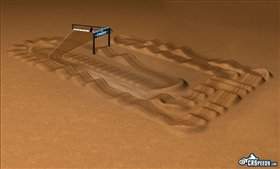 | | Dirt Wurx's Rich Winkler | | photo by Steve Bruhn |
|
|
With the opening round of the 2007 Amp’d Mobile World Supercross Series GP almost upon us, we thought we would track down Rich Winkler from Dirt Wurx to discuss the tracks he and his crew will be building in Toronto and Vancouver over the next two weeks.
Racer X: Rich, I guess, like an infantryman, you’re the first man in. How’s the weather in Toronto?
Rich Winkler: I’m not actually there yet! We’re actually not quite there yet. We had a little hang-up with our customs paperwork, and I had to have the customs broker refax me, so we’re on the road right now, in New York, but we’ll be there tonight sometime.
Well, I mentioned it on Racerhead last week, and it must go for you too: we close our eyes and another year goes by. Doesn’t it seem like we were just in Las Vegas—and I mean for the race in May, not the Open!
[Laughs] I know, I think it’s a symptom of the fact that we’re getting to be like 100 years old, too. Time just generally goes by faster—not just motocross time.
You and your crew do all of the tracks for the Amp’d Mobile series. What are some of the challenges you have going to Canada for these first two rounds?
Well, the biggest problem for us is sourcing the dirt, the trucking and everything—it has to be done kind of long-distance. Toronto is not as much of a problem as Vancouver because it’s a little closer, plus Carl Bastedo (of the CMA) is in town and he’s got some good connections and really helps us out.
Now Vancouver is a different deal altogether. The nuts-and-bolts stuff—dirt and tractors and diesel fuel and whatever—it’s tough. Vancouver is a booming construction city and to real construction people, ours is a little job. It’s hard to get anyone to take you seriously or give you good-guy prices or whatever. The last couple of weeks, we’ve been on the phone with people up there every day, looking around for stuff we need and just trying to make sure we have our ducks in a row before we head out.
 | | Toronto track map | | Illustration by Mike Fisher | |
|
Well, still, you have to admit it’s better in Vancouver than, say, Seville, Spain.
[Laughs] That’s true.
Fortunately, these two buildings are covered, but what about the dirt—where do you store it?
We don’t use the same dirt, and that’s part of what makes it a problem—we don’t have any storage capacity there like we do at most of the U.S. stadiums, so we have to find the stuff new, then get rid of it every year. The funny thing is, finding it is not usually a problem because there’s always construction going on and there’s dirt moving around, and coming out of excavation, it’s dry—it’s not sitting around in a pile somewhere. The problem is getting rid of it.
Can’t you just do it like The Great Escape when they were tunneling out of prison, and just have each person put some in their pants pockets and then drop it out on the sidewalks when they leave?
[Laughs] I’m all for that!
Something that people have been talking about a lot in the last couple of years, and you’re right there at the forefront of this ... how has the influx of four-strokes—particularly the 450s—changed supercross track theory?
That’s a good question. Part of that whole good track, bad track thing that came up again last year after years and years and years of it being fine came from that. We’ve always had a good feeling for what makes a good racetrack and a good rapport with the top riders, so that if there was a problem, it was handled amongst us, then by the time the show arrived, everyone was pretty happy with the track. But last year there was suddenly quite a bit of commentary about the track and, from our point of view, the tracks weren’t appreciably different than they’ve been for years, but there’s a group saying they’re too easy, a group saying they’re too technical, and so on.
Where does it comes from? A couple things: One, the four-strokes react differently to the course. They have some huge strengths as far as speed on the straightaways, speed on the whoops sections, but they have some negatives too, like putting them down exactly where you want them on tight rhythm sections and things like that.
The second thing was doing away with the Friday practice sessions. I mean, that practice was a pain in the neck for us, but it gave us a little preview on how everything was going to work and a chance to make some changes before Saturday—we had all night. Now we have about a 20-minute window between the two practices on Saturday where it’s pretty risky to make a big change, because you don’t have any way to change it back if it doesn’t work.
What was the first supercross race you worked on?
The 1981 Los Angeles Coliseum race. My introduction to this business was working as an employee for Mike Goodwin, so it was a shocker.
Really? What’s he been up to lately?
[Laughs] No comment.
 | | Vancouver track map | | Illustration by Mike Fisher | |
|
Well, I asked about your first race because I wanted to see if you were around in the era of the old 500cc supercross tracks. Because now the power is so steep on these bikes that it seems like James Stewart can hit the dropped starting gate and jump everything on the track. The “ups” these guys have are just amazing now. In the hands of a James, a Ricky, a Chad, Tedesco, Windham .… it makes it tough to find a track that not only challenges them but is also rideable for everyone else.
Well, unless they start experimenting with scaffolding and artificial obstacles and things like that—which I think is going to happen in the future, though not in 2007, but fairly soon, I think we’ll be looking at creating terrain and such inside the stadiums—but with what we have now you have a more or less fixed bag of obstacles that you can play with and put in different sequences and patterns and things. On two-stroke 250s, the tight, together, and very consistent obstacles, more or less at the same space all the way down the lane, worked really well because there was no obvious take off or landing point, so the option, or rhythm, was there for the whole main event.
But the four-strokes do a lot of that rhythm stuff so easy that instead of having double-double-double, somebody pretty quickly figures out how to triple-triple the whole lane. So what’s the alternative? If you start spacing stuff further apart, then there’s an obvious take-off and landing point and the choice is completely eliminated. I mean, I don’t know … I’ve looked at some of the stuff that’s being done outdoors or even Jeremy’s race, and just seeing if anything is being done that’s really innovative, but that’s escaping us, and I think just industry-wide there’s a little bit of head-scratching going on as to what makes the best battlefield for these guys. Even at the nationals, several of the tracks put in extremely tight, supercrossy sections, because the speeds were so high that the lap times had gotten down to the point where they didn’t make sense.
What about a long-term fix, something like bringing the CC’s down? There are so many things to weigh, with safety first, then the competition, then the show…
At the level of Ricky and James and Chad, it’s going to be a show no matter what. I’m old-school enough that I see a difference in the intensity now with the 450s, as compared to the 250 two-strokes. I mean, I miss the two-strokes, and I think the sport loses a little something without them—they should be at least part of the picture—but whenever anyone talks about making changes and leveling the playing field, I was always assuming that that’s where they were coming from, but the general consensus now is that the two-strokes are dead and they’re just looking to move on now. I hope that’s not the case, but I don’t want to go the other way either—I think the four-strokes are great, and they are here to stay—but I would like it to be a mix.
So … three-strokes?
[Laughs] Wow, never thought of that.
Okay, well good luck in getting through customs tonight Rich, and we’ll see you in Toronto.
Thanks, DC.





